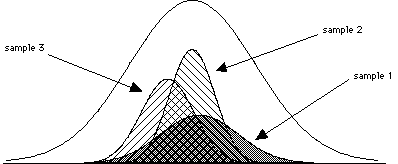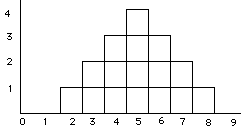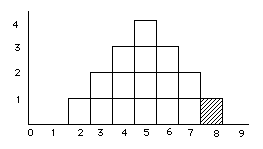Outline
|
 |
Lab 14
|
Hypothesis TestingIn the section of the course we learned to use the descriptive statistical procedures to describe distributions (and relationships between distributions). In the remainder of the course we will focus on inferential statistical procedures, which are used to make claims about the populations based on data collected from samples. In today's lab we will begin discussing the inferential procedure of Hypothesis testing. The reasoning of statistical tests is based on asking what would happen if we repeated the experiment over and over again.
Let's look at each of these steps in more detail.
Step1: Make a hypothesis and select a criteria for the decision
- your hypothesis is an educated guess/prediction about the effect of particular events/treatments/factors (which result in differences between populations) - your hypothesis may be general (e.g., this course will change comprehension abilities), or specific (e.g., this course will improve comprehension abilities by at least 10%).
The alternative hypothesis (Ha) predicts that the independent variable will have an effect on the dependent variable for the population The hypothesis testing procedure assumes we are trying to reject the null hypothesis, not trying to prove the alternative hypothesis.
Alternatively, we could make a specific alternative hypothesis if we chose. This would change our H0 too. Let's consider the specific case above where we expect that the ad campaign will INCREASE voters. This means that we expect higher voting rates for our sample than is in the population (30%). Here our Ha is that m > 30%. That means that our H0 is m < or = 30%.
Try some on your own. Each of the following situations calls for a significance test for a population mean m. State the null hypothesis H0 and the alternative hypothesis Ha in each case.
(1b) Census Bureau data show that the mean household income in the area served by a shopping mall is $52,500 per year. A market research firm questions shoppers at the mall. The researchers suspect the mean household income of mall shoppers is higher than that of the general population. (1c) The examinations in a large psychology class are scaled after grading so that the mean score is 50. The professor thinks that one teaching assistant is a poor teacher and suspects that his students have a lower mean than the class as a whole. The TA's students this semester can be considered a sample from the population of all students in the course, so the professor compares their mean score with 50.
The other part of this step is to decide what criteria you are going to use to either reject or fail to reject (not accept) the null hypothesis. This is sometimes referred to as setting your a level (that's alpha level).
To deal with this problem the researcher must set a criteria in advance.
- H0 is wrong
- H0 is wrong
- 2 chances to be correct
Type I error (a, alpha) - the H0 is actually correct, but the experimenter rejected it
Type II error (b, beta)- the H0 is really wrong, but the experiment didn't give us the evidence we need to reject it
In scientific research, we typically take a conservative approach, and set our critera such that we try to minimize the chance of making a Type I error (concluding that there is an effect of something when there really isn't). In other words, scientists focus on setting an acceptable alpha level (a), or level of significance. The alpha level (a), or level of significance, is a probabiity value that defines the very unlikely sample outcomes when the null hypothesis is true. Whenever an experiment produces very unlikely data (as defined by alpha), we will reject the null hypothesis. Thus, the alpha level also defines the probability of a Type I error - that is, the probability of rejecting H0 when it is actually true.
(2) A researcher would like to test the effectiveness of a newly developed growth hormone. The researcher knows that under normal circumstances laboratory rats reach an average weight of 1000 grams at 10 weeks of age. When the sample of 10 rats is weighed at 10 weeks, they weigh 1010 grams.
(b) Assuming that the growth hormone does have an effect, what would a type II error be in this situation?
Step 2: Collecting your sampleWhen we discussed z-scores, we were using z-scores to locate a score or set of scores in the population. Now we are dealing with situations in which we are looking not at single scores, but rather at samples of scores. These samples consist of scores that were randomly selected from a population of scores. As we saw in our earlier discussions of probability, random events are predicable in the long run. The following discussion and exercises demonstrate how we use this knowledge within the hypothesis testing framework to make claims about populations from samples. Suppose that you take 3 different random samples from the same population. They are probably going to be different from one another. See the figures below for an example of what I mean.
The samples may have different shapes, different means, and different variability. So how do you figure out what the best estimate of the population mean is? There are essentially an infinite number of samples that can be taken from a population if we sample with replacement (put the ones we choose back into the population each time). But the huge set of possible samples forms a simple, orderly, and predictable pattern (a sampling distribution). Because of this, we are able to base our predictions about sample characteristics on the distribution of sample means.
In other words, what we want to do is look at all of the possible samples (of a particular size, this part is important) and make predictions based on the properties of all of them. We do this the same way that we've done in the past, we essentially find the average of those properties. The Distribution of Sample MeansWe can create a distribution of sample means by looking at all possible samples of a certain size (n) and considering the means of each of those samples. Let's look at a concrete example:
Because this population is so small we actually can know the mean (and variability): mean = (2+4+6+8)/4 = 5, but suppose that we didn't, and wanted to be able to make an estimate of this population from samples chosen from the population (like we do when we conduct a research study). step 1: pick a sample size: for this example we'll pick samples of n = 2
step 2: Because we selected such a small population, we can actually consider all of the possible samples that you could get (ignoring duplications resulting from sampling with replacement), and look at their distribution.
____________________________________ scores sample mean sample first second (
step 3: Now you're ready to answer
questions like: What is the probability of
getting a sample with a mean greater than 7?
p( look at our distribution of sample means, we find that 1 out of 16 have a mean greater than 7. So that's our answer: 1/16 = .0625 = 6.25%
|
||||||||||||||||||||||||||||||||||||||
| The standard deviation of the distribution of sample means is called the standard error. The standard error is influenced by two factors: the variability of the population (s) and the sample size (n). |
We'll consider each of these factors below:
-
(A) the variability
of the population - the bigger the
variability of the population, the more
variability you'll have in the sample means.
 large s big differences from the pop mean |
 small s small differerences from the pop mean |
(B) the size of the sample - the larger your sample size (n), the more accurately the sample represents the population. This is known as the Law of large numbers.
-
think of it this way:
 |
- If I randomly selected 1 score, how accurately will that score predict the population's mean? |
 |
- Suppose that I take 5 scores. Are things more accurate? |
 |
- What about 100 scores? |
These two characteristics are combined in the formula for the standard error.
standard error
= ![]()
Now go back to the distribution of sample means applet again (or click below to open it again).
We can use the applet to take samples of different sizes from the sample population for comparison. Set the bottom graph to take samples of size 20 (n=20) and to plot the "mean" (change the "none" to mean).
(7) Click on 1,000 sample button. This will take 1,000 samples of size n = 5 and 1,000 samples of size n = 20. What are the means of each of these sampling distributions? How do they compare? What are the standard errors (standard deviations of the sampling distributions) for each other?
The shape of the distribution of sample means.
Open up the distribution of sample means applet again.
We can change the shape of the population distribution.
(8) Change the "normal" option to "skewed." As in the exercise above, sample two different sizes n = 5 & n = 20. Click the "1,000 samples" button. How do the shape of these distributions look? Are they skewed or fairly symmetrical? Which appears to be closer to Normal (hint: you can click the "fit normal" boxes to overlay a normal distribution)?
Central limit theorem
All of these properties (shape, mean, variability) are covered in the Central Limit TheoremCentral Limit Theorem: For any population with mean m and standard deviation s, the distribution of sample means for sample size n will approach a normal distriution with a mean of m and a standard deviation of
as n approaches infinity.
Note: for practical purposes this holds true for n > 30 (that is, for samples larger than n = 30).
Using the Distribution of Sample Means to Determine Sample Likelihood
Often we are not concerned with where a single individual is in a distribution, but rather where a sample is in the distribution of sample means. This tells us how likely we are to get that sample from a specific population. We can do this with the z-score distribution (and the unit normal table) if we know that the distribution of sample means is normal. (Remember that using the Central Limit Theorem, we know the distribution of sample means is normal if n is greater than 30 OR the population is normal.)
Example:
Consider the following situation. An instructor is interested in the IQ of her students. She has 9 students in her class and thinks that they are, on the average, really smart. What is the probability that the group of students has a mean greater than or equal to 112?
Let's look at a different kind of example.In other words, we don't want to know the probability of each individual having a score of 112 or better separately. Instead we want to know as a group, what is the probability of getting an average score of 112 or better.
We need to start by getting the population parameters
for the standardized IQ test: mean = 100, standard deviation = 15
Next we need to get the mean and standard deviation of the distribution of the samples (note: we'll assume a normal distribution because the original population distribution of IQ scores is normally distributed) so that we can calculate the z-score.
m = 100 (because the population mean is 100).
=
= 15/sq. root of 9 = 15/3 = 5
Now we need to figure out the z-score that corresponds to this sample mean: the z-score formula pretty much looks like what we've used in the examples above (except now we're locating a sample in the distribution of sample means rather than finding a single score in a population): Z
=
so for our example:
Does this answer make sense? Let's look at the pictures of our distributions.P(
> 112) = P(Z
> (112 - 100)/ 5 ) = P(Z > 2.4) = 0.0082
In other words, the probability that we'll get a sample of size n = 9 students with an average IQ equal to or greater than 112 is very small (0.0082). In our next labs we will extend this result to make claims concerning hypotheses about our population and our sample.
Population distribution

- at first it looks wrong - it seems like 112 should be less than a z = 1, because 115 is where z should equal 1
Distribution of Sample means

- however, we must remember that this isn't the correct distribution to be looking at, we need to look at the distribution of sample means. -we know that the distribution of sample means has a standard error = 5 and a mean = 100.
- So 112 should have a z >2
Example:
How high a mean would a group of 25 have to have on IQ to be in the top 10% of the IQ distribution for groups of this size?
First we need to get the mean and standard deviation (i.e., standard error) for the distribution of the samples
(9) Suppose we think that listening to classical music will affect the amount of time it takes a person to fall asleep so we conduct a study to test this idea.population mean = 100
=
= 15/sq. root of 25 = 15/5 = 3
Now we need to work backwards because we don't know the z-score. We can determine the z-score for the range based on the portion of the distribution we're looking for. We want the top 10% of the distribution. This corresponds to a proportion of .1000 for the distribution. If we look in the unit normal table, we find that .1000 corresponds to a z-score of 1.28 (that's as close to .1000 as we can get). You can verify this by looking at the unit normal table.
So for our example:
so, for a group of 25 people, they'd have to have a mean of just under 104 to be in the top 10%
step 1: look at unit normal table for 10%
step 2: work backwards through the z-score formula to solve for

= z *
+ population mean = (1.28)(3) + 100 = 103.84
(a) Suppose that the average person in the population falls asleep in 15 minutes (without listening to classical music) with σ = 6 min, state the null and alternative hypotheses for this study.
(b) Assume that the amount of time it takes people in the population to fall asleep is normally distributed. In the study we have a sample of people listen to classical music and then we measure how long it takes them to fall asleep. Suppose the sample of 36 people fall asleep in 12 minutes. What is the probability of obtaining a sample mean of 12 minutes or smaller?
Next time: Finishing up hypothesis testing, steps 3 and 4



